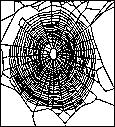
Huntsville, Alabama - Spray something nasty on a spider and it will spin a haywire web. That's what researchers at NASA's Marshall Space Flight Center have found. Citing previous studies, they propose using spiders instead of mammals as toxicity testers.
Because spider webs resemble crystal lattices, toxicologists can employ statistical crystallography to gauge a substance's toxicity. That means analyzing the number of completed cells, radii and other geometric structures in the web. The more toxic a substance, the more quantifiably deformed is the web.

![]()

It makes you wonder what their next study will be, my personal suggestions are:
On a More Serious Note: I felt sorry for the scientists performing this study for the reason that it is a useful and serious study of toxicology. While they may have expected to get a few respectful references in appropriate journals, they probably didn't expect to be laughed at in 20 to 30 popular publications. If this study hadn't been sanctioned by NASA, it probably would't have caused the publicity it did.
On Animal Testing: I wish I could say I was 'against' animal testing, but the simple fact is that everything sold in 1st world (western) countries is extensively tested. Can you recall seeing products emblazoned with the 'Not Tested on Animals' label? The first time I saw that caption I felt all ...warm & fuzzy inside. After I'd given it a bit of thought, I realised that this should have read 'Not Tested on Animals, We've Already Tested for Thousand's of Years on People'. If we stuck by this maxim we would never be able to introduce any new life saving or life extending drug.
Of course, you could argue that it's better to test on humans. There is always an element of doubt that results of animal studies transfer to people. The problem then is choosing which people to test. The insane, criminals, the homeless, children who don't eat their vegetables?
Until such times as we come up with a piece of software that accurately mimics the biology of a human being, as well as the hardware necessary to run it - I believe that animal testing is unavoidable.

P.S. The extra drug shown in the cycling picture is Chloral Hydrate, obtained direct from the PDF document kindly supplied by Linda Porter, of the Data Systems Branch at NASA's Marshall Space Flight Center, thanks Linda.
If you're interested in chasing it furrther, you might try The Marshall Library, it's officially known as MFS-28921 and comes from the April 1995 Tech Briefs.
Unfortunately, I was never able to track down a useful contact at the library. I'd love to have seen the other toxic substances they might have tried. LSD, PCP, Datura, Heroin…the mind boggles.
